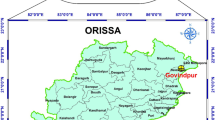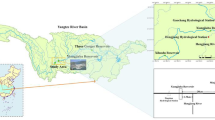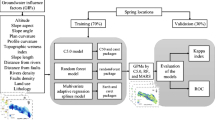Abstract
This paper employed two classical, popular decision-tree algorithms (C5.0 and CART), and traditional Regression to deal with reservoir operations regarding decision of the releases from a reservoir system during floods. The experiment site was in Shihmen Reservoir, located in northern Taiwan. In a typical single-peak typhoon, the rules derived include two operational stages, the stage before peakflow (Stage I) and the stage after peakflow (Stage II). This study collected 50 typhoons (1987–2009). Four cases are designed, that are discretized class labels (target fields) are run by C5.0 and CART (i.e., Cases 1 and 2, respectively), while numeric class labels are run by CART and Regression (i.e., Cases 3 and 4, respectively). The criteria of root mean square error (RMSE), coefficient of efficiency (CE), and relative error of peak discharge (EQp) were used to evaluate the forecasts. Results showed that the decision trees are skillful in the prediction of reservoir releases in the studied site. Furthermore, it was found that CART regression trees with numeric targets are more appropriate and precise than C5.0 classification trees and Regression for the prediction of releases.











Similar content being viewed by others
References
Apté C, Weiss S (1997) Data mining with decision trees and decision rules. Futur Gener Comput Syst 13:197–210
Bessler FT, Savic DA, Walters GA (2003) Water reservoir control with data mining. J Water Resour Plann Manag 129:26–34
Breiman L, Friedman JH, Olshen RA, Stone CJ (1984) Classification and regression trees. Wadsworth, Belmont
Brodley CE, Utgoff PE (1995) Multivariate decision trees. Mach Learn 19:45–77
Buntine W (1993) Learning classification trees. In: Hand DJ (ed) Artificial intelligence frontiers in statistics. Chapman & Hall, London, pp 182–201
Dougherty J, Kohavi R, Sahami M (1995) Supervised and unsupervised discretizations of continuous features. In: Proceedings of the 12th International Conference on Machine Learning. New York, Morgan Kaufmann, pp 194–202
Hsu N-S, Wei C-C (2007) A multipurpose reservoir real-time operation model for flood control during typhoon invasion. J Hydrol 336:282–293
Hunt EB, Marin J, Stone PJ (1966) Experiments in induction. Academic, New York
Kass GV (1980) An exploratory technique for investigating large quantities of categorical data. Applied Statistics 29:119–127
Kearns M, Mansour Y (1999) On the boosting ability of top-down decision tree learning algorithms. J Comput Syst Sci 58(1):109–128
Labadie JW (2004) Optimal operation of multireservoir systems: state-of-the-art review. J Water Resour Plann Manag 130(2):93–111
Lindo Systems Inc (2001) Lingo 7.0 user’s guide. Lindo Systems, Chicago
Li X, Guo S, Liu P, Chen G (2010) Dynamic control of flood limited water level for reservoir operation by considering inflow uncertainty. J Hydrol 391:124–132
Liu P, Guo S, Xu X, Chen J (2011a) Derivation of aggregation-based joint operating rule curves for cascade hydropower reservoirs. Water Resour Manag 25(13):3177–3200
Liu X, Guo S, Liu P, Chen L, Li X (2011b) Deriving optimal refill rules for multi-purpose reservoir operation. Water Resour Manag 25(2):431–448
Lund JR, Ferreira I (1996) Operating rule optimization for Missouri river reservoir system. J Water Resour Plann Manag 122(4):287–295
Mahjoobi J, Etemad-Shahidi A (2008) An alternative approach for the prediction of significant wave heights based on classification and regression trees. Appl Ocean Res 30:172–177
Mahjoobi J, Etemad-Shahidi A, Kazeminezhad MH (2008) Hindcasting of wave parameters using different soft computing methods. Appl Ocean Res 30:28–36
Nagesh Kumar D, Baliarsingh F, Srinivasa Raju K (2010) Optimal reservoir operation for flood control using folded dynamic programming. Water Resour Manag 24(6):1045–1064
Needham JT, David WW Jr, Jay RL (2000) Linear programming for flood control in the Iowa and Des Moines Rivers. JJ Water Resour Plann Manag 126(3):118–127
Quinlan JR (1979) Discovering rules by induction from large collection of examples. In: Michie D (ed) Expert systems in the micro electronic age. Edinburg University Press, Edinburg
Quinlan JR (1993) C4.5: Programs for machine learning. Morgan Kaufmann, San Mateo
Quinlan JR (1998) C5.0: An Informal Tuorial. RuleQuest. www.rulequest.com/see5-unix.html.
Rani D, Moreira MM (2010) Simulation-optimization modeling: a survey and potential application in reservoir systems operation. Water Resour Manag 24(6):1107–1138
Rissanen J, Wax M (1998) Algorithm for constructing tree Structured classifier. US Patent No 4719571
Safavian SR, Landgrebe D (1998) A survey of decision tree classifier methodology. IEEE Trans Syst Man Cybern 22:660–674
Sreerama KM (1998) Automatic construction of decision trees from data: a multidisciplinary survey. Data Min Knowl Disc 2:245–389
Tan P-N, Steinbach M, Kumar V (2006) Introduction to data mining. Addison Wesley, Boston, pp 193–195
Ticlavilca AM, McKee M (2011) Multivariate Bayesian regression approach to forecast releases from a system of multiple reservoirs. Water Resour Manag 25(2):523–543
Twala BETH, Jones MC, Hand DJ (2008) Good methods for coping with missing data in decision trees. Pattern Recognit Lett 29(7):950–956
Verplancke T, Van Looy S, Benoit D, Vansteelandt S, Depuydt P, De Turck F, Decruyenaere J (2008) Support vector machine versus logistic regression modeling for prediction of hospital mortality in critically ill patients with haematological malignancies. BMC Med Inform Decis Making 8(56):1–8
Wasimi SA, Kitanidis PK (1983) Real-time forecasting and daily operation of a multireservoir system during floods by linear quadratic Gaussian control. Water Resour Res 19(6):1511–1522
Wei C-C, Hsu N-S (2008a) Multireservoir flood-control optimization with neural-based linear channel level routing under tidal effects. Water Resour Manag 22(11):1625–1647
Wei C-C, Hsu N-S (2008b) Multireservoir real-time operations for flood control using balanced water level index method. J Environ Manag 88(4):1624–1639
Wei C-C, Hsu N-S (2009) Optimal tree-based release rules for real-time flood control operations on a multipurpose multireservoir system. J Hydrol 365:213–224
Windsor JS (1973) Optimization model for the operation of flood control systems. Water Resour Res 9(5):1219–1226
WRA (2002) Guidelines of Shihmen Reservoir operations. Water Resources Agency, Taoyuan, in Chinese
Wurbs RA (1993) Reservoir-system simulation and optimization models. J Water Resour Plann Manag 119(4):455–472
Xu ZX, Li JY (2002) Short-term inflow forecasting using an artificial neural network model. Hydrol Process 16(12):2423–2439
Yeh WW-G (1985) Reservoir management and operation models: a state-of-the-art review. Water Resour Res 21(12):1797–1818
Young GK Jr (1967) Finding reservoir operating rules. J Hydraul Div 93:297–321
Acknowledgements
The support under Grant No. NSC100-2111-M-464-001 by the National Science Council, Taiwan is greatly appreciated. The writer is also grateful for the constructive comments of the referees.
Author information
Authors and Affiliations
Corresponding author
Rights and permissions
About this article
Cite this article
Wei, CC. Discretized and Continuous Target Fields for the Reservoir Release Rules During Floods. Water Resour Manage 26, 3457–3477 (2012). https://doi.org/10.1007/s11269-012-0085-2
Received:
Accepted:
Published:
Issue Date:
DOI: https://doi.org/10.1007/s11269-012-0085-2




